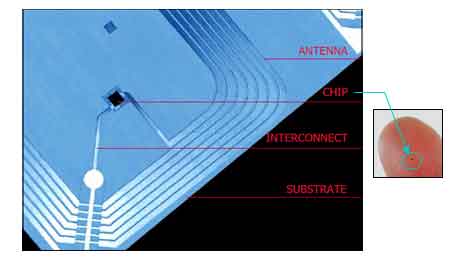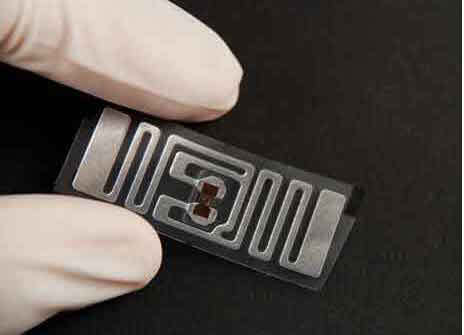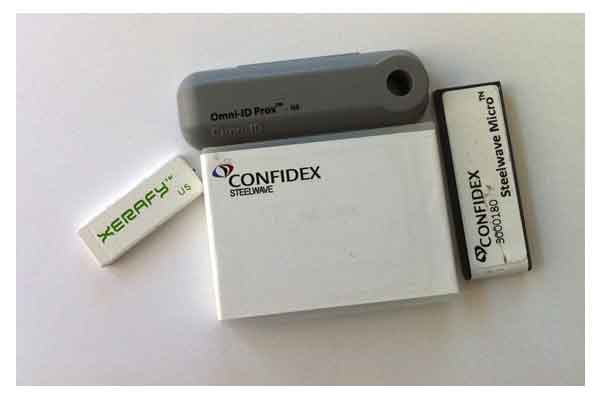Explore / RFID Basics & Resources
Dig Deep – Construction of RFID Tags
RFID tags, along with interrogators, antennas, and peripheral devices, form a physical layer of the RFID system. As you know, RFID tags use electromagnetic wave propagation and inductive and backscatter coupling to communicate with interrogators. But how are these tags made? Let’s discuss tag components including the RFID chip and its construction.
TAG COMPONENTS AND CONSTRUCTION
RFID tags are made of three different components: an RFID chip, which is an integrated circuit (IC), an antenna, and a substrate. A tag manufacturer typically does not make all three components in-house. The IC is typically designed and made by a semiconductor manufacturer, while an antenna is usually designed and made by a tag manufacturer. Tags are available in various sizes, designs, and form factors, and they can be customized for a particular application. Unless you need a very large number of tags, you should try to use stock tags because customized tags can be very expensive.
RFID CHIP (IC)
An IC, also called an electronic circuit, microchip, or chip, is designed and manufactured by a semiconductor manufacturer.
The IC has a logic unit that makes decisions and provides memory to store data. Actually, the IC is a small microprocessor, and the latest ones have 40 to 50 thousand transistors, more than the original IBM PC. The IC needs power to operate. This power may come from a battery on the tag (in an active tag) or it may be obtained from the radio energy radiated by the interrogator antenna (in a passive tag). A part of the IC is dedicated to controlling power.

The processing logic implements the communication protocol. It also is used to modulate/demodulate signals and to encode/decode digital bits during the communication between the interrogator and the tag. The memory on the IC may be divided in different blocks, called banks. A block may be a read-only type, a write-only-one-time type, or a write-many-times type. Tags use electrically erasable, programmable, read-only memory (EEPROM). This type of memory does not require continuous power to store data. Therefore, data stored on the tag is retained for a long period (several years), even though no power may be available to the tag during this period. The type of data stored in the memory depends on the protocol used. The IC may store tag ID, object identifier, password, and error detection code such as cyclic redundancy code (CRC). ICs are created on a large semiconductor wafer. One wafer can contain 40,000 ICs. Manufacturing of ICs requires state-of-the-art clean room facilities. The finished ICs are individually tested to ensure reliable functionality in the field. With advances in semiconductor technology, ICs are becoming smaller—as small as grain of sand. The smaller the IC, the lesser the cost and power required to operate it. Making tag ICs more efficient in power usage and requiring less power to operate increases the read range of passive tags.
The ICs on each wafer need to be cut and separated and then attached to a tag antenna. As the size of IC decreases, it requires more precise equipment to connect it to the antenna, which can increase the cost of assembling the tag.
TAG ANTENNA
The antenna is the largest part of the tag and is connected to the tag IC. The antenna receives the signals from the interrogator and, depending on tag type, it either transmits or reflects the received signal back. For active tags, it transmits the signals, and for semi-passive and passive tags, it reflects the signals. For passive tags, the antenna also collects power from the radio waves and supplies it to the IC.
The geometry of an antenna is determined by the frequency at which the tag operates. Though the tags may use the identical IC, variations in antenna design allow tags to have completely different properties and behaviors. The antenna can be shaped as a spiral coil, a single dipole, dual dipoles (one perpendicular to other), or a folded dipole. Within these basic types are many variations in antenna shapes, depending on the specific requirements of the application and the abilities of the designer. The antenna is designed for a specific frequency of operation and is later tuned according to the properties of the material to be tagged. The designated frequency determines the effective antenna length, but the actual antenna length is typically reduced using creative antenna design.
Antennas are usually made of thin metal strips of copper, aluminum, or silver. These strips are deposited on the substrate at high speeds, using one of three different methods: copper etching, foil stamping, and screen-printing. Screen-printing is the fastest and the least expensive of all three processes, but the antennas created using this method are less efficient than those created by the other two methods. Because many tags will be included in the labels and the label makers’ expertise is in printing, a screen-printed antenna using conductive ink containing copper, nickel, or carbon would make the tag creation process less expensive and will integrate it with the label making process.
SUBSTRATE
The substrate holds all other tag components together. The tag antenna is deposited or printed on the substrate, and the IC is then attached to this antenna. A substrate is usually made from flexible material such as thin plastic, but it may also be made from rigid material. Most passive tags use substrates made from flexible material with a thickness of 100 to 200 nm. The substrate material must be able to withstand various environmental conditions through which the tag may pass during its lifecycle. Some of the materials used for the substrate are polymer, PVC, Polyethylenetherephtalate (PET), phenolics, polyesters, styrene, and even paper. The substrate material must provide dissipation of static buildup, a smooth printing surface for antenna layout, durability and stability under various operating conditions, and mechanical protection for the antenna, chip, and their interconnections. Some of the environmental conditions that can affect the substrate are heat, moisture, vibration, chemicals, sunlight, abrasion, impact, and corrosion. The substrate material may affect the design frequency of the antenna; therefore, the effect of substrate material must be considered during proper tuning of the antenna.
One side of the substrate is usually coated with an adhesive material to attach the tag to an object. The adhesive material must be able to withstand appropriate environmental conditions. Sometimes, a protective overlay made from materials such as PVC lamination, epoxy resin, or adhesive paper is added to protect the tag from environmental effects.
TAG PACKAGING
INLAYS
Tag usually starts as an inlay (or insert), which is essentially a complete tag that is ready to be embedded in a label or encapsulated. An inlay consists of an IC, an antenna, attached to the substrate. Typically, the substrate does not have an adhesive. The inlays are supplied on a reel of continuous web and are used by label makers, also called converters, to embed RFID functions into labels. The continuous form of inlays helps assemble labels on high-speed equipment.

SMART LABELS
Tag usually starts as an inlay (or insert), which is essentially a complete tag that is ready to be embedded in a label or encapsulated. An inlay consists of an IC, an antenna, attached to the substrate. Typically, the substrate does not have an adhesive. The inlays are supplied on a reel of continuous web and are used by label makers, also called converters, to embed RFID functions into labels. The continuous form of inlays helps assemble labels on high-speed equipment.

ENCAPSULATED TAGS
RFID inlays are sometimes encapsulated inside a hard case. The case is made of RF translucent materials such as PET, Polypropylene (PP), Polyacetate (POM), Polycarbonate (PC), Acrylonitrile Butadiene Styrene (ABS), Polyamide 66P (A66), and Elastomère (EPDM). Tags are encapsulated to protect them from harsh environments. For example, a tag attached to a reusable plastic container (RPC) used in a food processing plant would encounter high temperature, pressure, and steam when the container is sanitized. These tags are used to track totes, carriers, and pallets in closed-loop systems and returnable assets in the supply chain. Some of the cases may provide a more rugged method of tag attachment, such as bolting or riveting to the object. In addition, the size and shape of the case may be designed to provide isolation from the object so the tag may be attached to metal objects.
